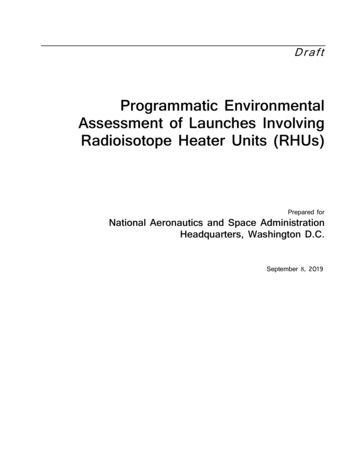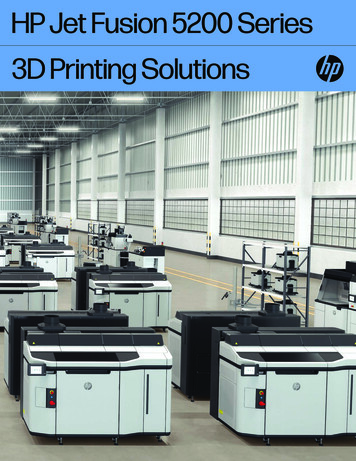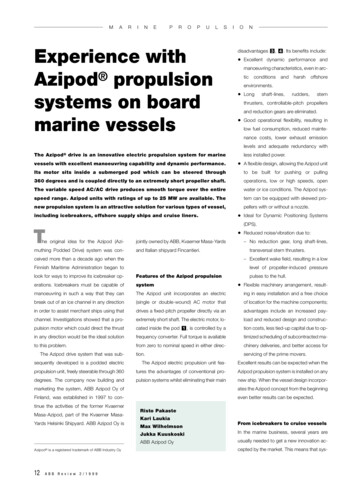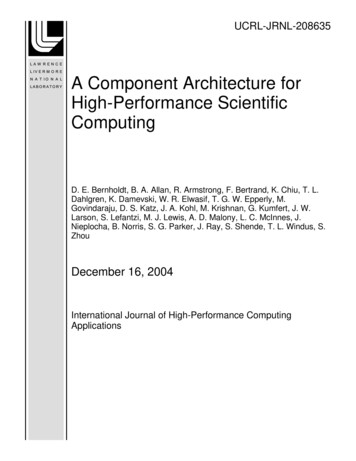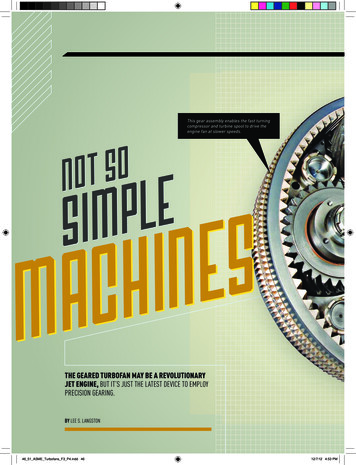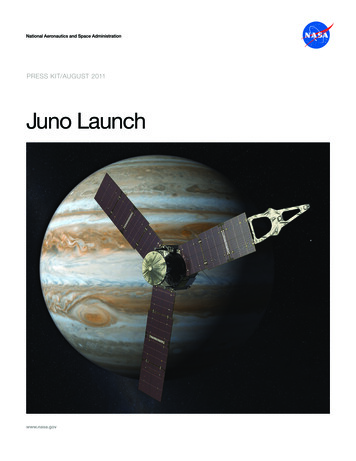
Transcription
PRESS KIT/AUGUST 2011Juno Launch
Media ContactsDwayne BrownNASA 358-1726dwayne.c.brown@nasa.govDC AgleJuno MissionJet PropulsionLaboratoryPasadena, Calif.818-393-9011agle@jpl.nasa.govMaria MartinezScience InvestigationSouthwest Research InstituteSan Antonio210-522-3305maria.martinez@swri.orgGary NapierSpacecraftLockheed Martin Space o Launch2Press Kit
ContentsMedia Services Information. . . . . . . . . . . . . . . . . . . . . . . . . . . . . . . . . . . . . . . . . . . . . . . . . . . . . . 5Quick Facts . . . . . . . . . . . . . . . . . . . . . . . . . . . . . . . . . . . . . . . . . . . . . . . . . . . . . . . . . . . . . . . . . 6Jupiter at a Glance . . . . . . . . . . . . . . . . . . . . . . . . . . . . . . . . . . . . . . . . . . . . . . . . . . . . . . . . . . . . 7Why Juno? . . . . . . . . . . . . . . . . . . . . . . . . . . . . . . . . . . . . . . . . . . . . . . . . . . . . . . . . . . . . . . . . . . 8Mission Overview . . . . . . . . . . . . . . . . . . . . . . . . . . . . . . . . . . . . . . . . . . . . . . . . . . . . . . . . . . . . . 9Mission Phases . . . . . . . . . . . . . . . . . . . . . . . . . . . . . . . . . . . . . . . . . . . . . . . . . . . . . . . . . . . . . . 10Spacecraft . . . . . . . . . . . . . . . . . . . . . . . . . . . . . . . . . . . . . . . . . . . . . . . . . . . . . . . . . . . . . . . . . .15Science Overview. . . . . . . . . . . . . . . . . . . . . . . . . . . . . . . . . . . . . . . . . . . . . . . . . . . . . . . . . . . . 21Missions to Jupiter . . . . . . . . . . . . . . . . . . . . . . . . . . . . . . . . . . . . . . . . . . . . . . . . . . . . . . . . . . . 23Program/Project Management . . . . . . . . . . . . . . . . . . . . . . . . . . . . . . . . . . . . . . . . . . . . . . . . . . 24Juno Launch3Press Kit
Media Services InformationNASA Television TransmissionLaunch StatusThe NASA TV Media Channel is available on an MPEG-2digital C-band signal accessed via satellite AMC-6, at 72degrees west longitude, transponder 17C, 4040 MHz,vertical polarization. In Alaska and Hawaii, it’s availableon AMC-7 at 137 degrees west longitude, transponder 18C, at 4060 MHz, horizontal polarization. A DigitalVideo Broadcast compliant Integrated Receiver Decoderis required for reception. For digital downlink informationfor NASA TV’s Media Channel, access to NASA TV’sPublic Channel on the Web and a schedule of programming for Juno activities, visit http://www.nasa.gov/ntv .Recorded status reports will be available beginning twodays before launch at 321-867-2525 and 301-286NEWS.Internet InformationMore information on the Juno mission, including anelectronic copy of this press kit, news releases, statusreports and images, can be found at http://missionjuno.swri.edu/ and http://www.nasa.gov/juno/ .Media CredentialingNews media representatives who wish to cover the Junolaunch must contact NASA Kennedy Space CenterPublic Affairs in advance at: 321-867-2468.BriefingsA pre-launch news conference will be held at theKennedy Space Center Press Site at 1 p.m. EDT onAug. 3, 2011. The news conference will be televised onNASA TV.Juno Launch5Press Kit
Quick FactsMission NameJuno Mission Milestones and Distances TraveledThe Juno spacecraft will, for the first time, see belowJupiter’s dense cover of clouds. This is why the mission was named after the Roman goddess, who wasJupiter’s wife, and who could also see through clouds.Launch period: Aug. 5–26, 2011 (22 days)Launch location: Pad SLC-41, Cape Canaveral Air ForceStation, Fla.SpacecraftEarth–Jupiter distance at time of launch: 445 millionmiles (716 million kilometers)Dimensions: 11.5 feet (3.5 meters) high, 11.5 feet(3.5 meters) in diameter.Time it takes light to travel from Earth to Jupiter onAug. 5, 2011: 39 minutes, 50 secondsSolar Arrays: length of each solar array 29.5 feet (9 meters) by 8.7 feet (2.65 meters). Total surface area ofsolar arrays: more than 650-feet (60-meters) squared.Total number of individual solar cells: 18,698. Totalpower output (Earth distance from sun): approximately14 kilowatts; (Jupiter distance from sun): approximately400 watts.Earth gravity assist flyby: October 9, 2013Distance Juno travels launch to Earth gravity assist:994 million miles (1,600 million kilometers)Juno’s altitude over Earth’s surface at closest point during gravity assist: 311 miles (500 kilometers)Jupiter arrival: July 4, 2016, 7:29 p.m. (PDT)Weight: 7,992 pounds (3,625 kilograms) total at launch,consisting of 3,513 pounds (1,593 kilograms) of spacecraft, 2,821 pounds (1,280 kilograms) of fuel and1,658 pounds (752 kilograms) of oxidizer.Distance of Jupiter to Earth at time of Jupiter orbit insertion: 540 million miles (869 million kilometers)One-way speed-of-light time from Jupiter to Earth in July2016: 48 minutes, 19 secondsLaunch VehicleTotal distance traveled, launch to Jupiter orbit insertion:1,740 million miles (2,800 million kilometers)Type: Atlas V551 (Atlas first stage with five solid rocketboosters, Centaur upper stage)End of mission (deorbit): October 16, 2017Height with payload: 197 feet (60 meters)Distance traveled in orbit around Jupiter: 348 millionmiles (560 million kilometers)Mass fully fueled: 1,265,255 pounds (574,072 kilograms)Total distance, launch through Jupiter impact: 2,106 million miles (3,390 million kilometers)ProgramThe Juno mission investment is approximately 1.1 billion in total. This cost includes spacecraft development, science instruments, launch services, missionoperations, science processing and relay support for74 months.Juno Launch6Press Kit
Jupiter at a GlanceIf you take everything else in the solar system (not including the sun), it would all fit insideJupiter tapers into a windsock-shaped tail extending more than600 million miles (1 billion kilometers) behind Jupiter, asfar as Saturn’s orbit.The largest and most massive of the planets wasnamed after the king of the gods, called Zeus by theGreeks and Jupiter by the Romans; he was the mostimportant deity in both pantheons.On Jan. 7, 1610, using his primitive telescope, astronomer Galileo Galilei saw four small “stars” near Jupiter.He had discovered Jupiter’s four largest moons, nowcalled Io, Europa, Ganymede and Callisto. These fourmoons are known today as the Galilean satellites. Notincluding the “temporary” moons, Jupiter has 64 confirmed moons. (Temporary moons are comets that havebeen temporarily captured by Jupiter’s massive gravityfield. These temporary satellites may circle Jupiter foryears before continuing on their way through the solarsystem or burn up as they enter its atmosphere.) Jupiterhas three thin rings around its equator, which are muchfainter than the rings of Saturn. Jupiter’s rings appear toconsist mostly of fine dust particles and may be formedby dust kicked up as interplanetary meteoroids smashinto the giant planet’s four small inner moons. They werediscovered in 1979 by NASA’s Voyager 1 spacecraft.As the most massive inhabitant of our solar system,and with four large moons of its own and many smallermoons, Jupiter forms its own kind of miniature solarsystem. In fact, Jupiter resembles a star in composition, and if it had been about 80 times more massive, itwould have become a star rather than a planet.Jupiter’s appearance is a tapestry of beautiful colorsand atmospheric features. Most visible clouds arecomposed of ammonia. Water clouds exist deep belowand can sometimes be seen through clear spots in theclouds. The planet’s “stripes” are created by strongeast-west winds in Jupiter’s upper atmosphere. Withinthese belts and zones are storm systems that can ragefor years. The Great Red Spot, a giant spinning storm,has been observed for more than 300 years. In recentyears, three storms merged to form the Little Red Spot,about half the size of the Great Red Spot.The composition of Jupiter is similar to that of the sun —mostly hydrogen and helium. Deep in the atmosphere,the pressure and temperature increase, compressingthe hydrogen gas into a liquid. At depths of about a thirdof the way down, the hydrogen becomes a liquid thatconducts electricity like a metal. It is in this metallic layerthat scientists think Jupiter’s powerful magnetic field isgenerated by electrical currents driven by Jupiter’s fastrotation. At the center, the immense pressure may support a core of heavy elements much larger than Earth.Significant Dates in Jovian HistoryJupiter’s enormous magnetic field is nearly 20,000times as powerful as Earth’s. Trapped within Jupiter’smagnetosphere (the vast area of space that the planet’smagnetic field dominates) are swarms of charged particles. The magnetic field traps some of these electronsand ions in an intense radiation belt that bathes Jupiter’srings and moons. The Jovian magnetosphere, comprising these particles and fields, balloons 600,000 to 2 million miles (1 to 3 million kilometers) toward the sun andJuno Launch7 1610: Galileo Galilei makes the first detailedobservations of Jupiter. 1973: NASA’s Pioneer 10 becomes the firstspacecraft to cross the asteroid belt and flypast Jupiter. 1979: NASA’s Voyager 1 and 2 discoverJupiter’s faint rings, several new moons andvolcanic activity on Io’s surface. 1994: Astronomers and NASA’s Galileo spacecraft observe as pieces of comet ShoemakerLevy 9 collide with Jupiter’s southern hemisphere. 1995: The Galileo spacecraft and probe arriveat Jupiter to explore Jupiter’s atmospheredirectly for the first time and to conduct anextended study of the giant planet system.Press Kit
Why Juno?Juno’s primary goal is to reveal the story of the formationand evolution of the planet Jupiter. Using long-proventechnologies on a spinning spacecraft placed in an elliptical polar orbit, Juno will observe Jupiter’s gravity andmagnetic fields, atmospheric dynamics and composition, and the coupling between the interior, atmosphereand magnetosphere that determines the planet’s properties and drives its evolution. An understanding of theorigin and evolution of Jupiter, as the archetype of giantplanets, can provide the knowledge needed to help usunderstand the origin of our solar system and planetarysystems around other stars.Jupiter is by far the largest planet in the solar system.Humans have been studying it for hundreds of years,yet still many basic questions about the gas worldremain. In 1995, NASA’s Galileo mission made the voyage to Jupiter. One of its jobs was to drop a probe intoJupiter’s atmosphere. The data returned from that probeshowed us that Jupiter’s composition was different thanscientists thought, indicating that our theories of planetary formation were wrong. Today, there remain majorunanswered questions about this giant planet and theorigins of our solar system hidden beneath the cloudsand massive storms of Jupiter’s upper atmosphere. How did Jupiter form? How much water or oxygen is in Jupiter? What is the structure inside Jupiter? Does Jupiter rotate as a solid body, or is the rotatinginterior made up of concentric cylinders? Is there a solid core, and if so, how large is it? How is its vast magnetic field generated? How are atmospheric features related to the movement of the deep interior? What are the physical processes that power theauroras? What do the poles look like?Juno Launch8Press Kit
Mission OverviewTo accomplish its science objectives, Juno orbits overJupiter’s poles and passes very close to the planet.Juno needs to get extremely close to Jupiter to makethe very precise measurements the mission is after. Thisorbital path carries the spacecraft repeatedly throughhazardous radiation belts — but avoids the most powerful radiation belts. Jupiter’s radiation belts are analogousto Earth’s Van Allen belts — but far more deadly.The Juno spacecraft is scheduled to launch aboard anAtlas V551 rocket from Cape Canaveral, Fla., in Aug.2011, reaching Jupiter in July 2016.Following launch from Cape Canaveral Air Force Station,Fla., the Juno spacecraft is scheduled to use its mainrocket motor twice (for an Aug. 5 launch, it would beused on Aug. 30, and Sept. 3, 2012) to modify itstrajectory towards Jupiter. During cruise, there are also13 planned trajectory correction maneuvers to refine itsorbital path. An Earth flyby 26 months after launch willprovide a boost of spacecraft velocity, placing it on atrajectory for Jupiter. The transit time to Jupiter followingthe Earth flyby is about three years, including the periodof the initial capture orbit. The 30-minute orbit insertionburn will place Juno in orbit around Jupiter in early July2016.Juno LaunchThe spacecraft will orbit Jupiter 33 times, skimming towithin 3,100 miles (5,000 kilometers) above the planet’scloud tops every 11 days, for approximately one year.9Press Kit
Mission PhasesPre-Launch PhaseThirteen mission phases have been definedto describe the different periods of activityduring Juno’s travels.These phases are:Pre-Launch, Launch,Inner Cruise 1, InnerCruise 2, Inner Cruise3, Quiet Cruise, JupiterApproach, JupiterOrbit Insertion, CaptureOrbit, Period ReductionManeuver, Orbit 1-2,Science Orbits andDeorbit.The Flight System is mated to the launch vehicle atL-10 days. Juno uses Space Launch Complex 41(SLC-41) at Cape Canaveral Air Force Station, thesame launch pad used by NASA’s New Horizons mission and other Atlas V launch vehicles.The Pre-Launch mission phase lasts from spacecraftpower-up at L-3 days to final spacecraft configurationat L-45 minutes. Juno’s launch period lasts 22 days(Aug. 5–26, 2011) with a launch window at least 60minutes in duration every day of the launch period. Thelaunch period has been optimized to maximize injectedmass into Jupiter science orbits.JunoSpacecraftLaunch VehicleThe Atlas V551 is a twostage launch vehicle thatuses a standard Atlasbooster with five solidrocket boosters in the firststage and a Centaur upperstage for the second. TheCentaur upper stage hasa restartable engine andis three-axis stabilized.Guidance and navigationare provided by the Centaurfollowing launch. The Junospacecraft is enclosed forthe flight through Earth’satmosphere in the Atlas’s16.4-foot (5-meter) diameter, 68-foot (20.7-meter)long payload fairing.Forward LoadReactor (FLR)RL 10A CentaurEngineAtlas V BoosterCentaurSolid AdapterRD-180EngineJuno InterstageAdapterLaunch vehicle10Press Kit
The launch vehicle is throttled to maintain 2.5 g’s forPayload Fairing Jettison, which occurs a little underthree-and-a-half minutes after launch. Following jettison of the payload fairing, acceleration is maintainedat 5.0 g’s until booster engine cutoff. The Atlas/Centaurseparation occurs approximately six seconds afterbooster engine cutoff. The first burn of the second stageof the Centaur rocket begins 10 seconds after the separation. The first Centaur burn lasts about six minutesand completes when the vehicle has achieved its targetparking orbit.Boost Profile and InjectionThe boost phase begins with the ignition of the boosterengine system. Liftoff occurs when the Atlas’s five solidrocket boosters are ignited.Upon burnout of the solid rocket boosters (at approximately 104 seconds after launch) they are staggerjettisoned: first solids 1 and 2, then 1.5 seconds later,solids 3, 4 and 5.Launch profileJuno Launch11Press Kit
Following the completion of its second burn, theCentaur turns to a pre-planned separation attitude andinitiates a 1.4 revolutions per minute roll rate. The Junospacecraft is scheduled to separate from its Centaurbooster about three-and-a-half minutes after theCentaur completes its burn. At the time of separation,a clampband releases and push-off springs push theJuno spacecraft from the Centaur.During the parking orbit coast period (approximately30 minutes in length), the Centaur turns itself and thespacecraft to the required attitude for the start of itssecond burn. The Centaur’s second burn (approximately nine minutes in length) places Juno on the desireddeparture trajectory.Solar Array DeploymentTransition to the Cruise mission phase is expected tooccur three days after launch.Juno’s massive solar arrays are scheduled to begin deployment about five minutes following separation. Thelength of time it takes for deployment is expected to beless than three minutes.Solar array deployment sequenceCruise PhasesJuno’s trajectory to Jupiter consists of five phases overfive years and one-and-a-half loops of the sun.There are four cruise phases: Inner Cruise 1 (61 days),Inner Cruise 2 (598 days), Inner Cruise 3 (161 days), andQuiet Cruise (791 days).During cruise, the spacecraft is usually oriented so thatits high-gain antenna is Earth-pointed. However, closeto the sun there are times where thermal and powerrequirements do not allow for Earth-pointing of the antenna. At these times the spacecraft is pointed off-sunin such a way that thermal requirements can be met.Inner Cruise Phase 1The Inner Cruise 1 phase spans the interval from L 3 toL 63 days. It is characterized by initial spacecraft andinstrument checkouts, deployment of the Waves instrument antenna, Juno’s first trajectory correction maneuver, and the location of the spacecraft far enough fromthe sun to allow Earth-pointing instead of sun-pointing.Juno LaunchEarth–Jupiter trajectory12Press Kit
phase ends at Jupiter Orbit Insertion minus four days,which is the start of the critical sequence that will resultin the spacecraft orbiting Jupiter.Inner Cruise Phase 2The Inner Cruise 2 phase spans the period from L 63days until L 661 days (1.6 years in length). The mission’s two deep space maneuvers occur during thisphase, prior to the spacecraft’s one Earth flyby. Otherspacecraft activities during the Inner Cruise 2 phase include calibrations and alignments associated with usingthe high-gain antenna for the first time. The spacecraft’sscience instruments are also checked out again.This phase is characterized by instrument checkouts aswell as initial science observations of Jupiter. Calibrationsand science observations performed during this phasego a long way toward validating instrument performancein the Jupiter environment, testing the data processingpipeline, and preparing the team for successfully returning baseline Jupiter science data starting in Orbit 3.Inner Cruise Phase 3Jupiter Orbit Insertion PhaseThe Inner Cruise 3 phase spans the interval from L 661days to L 822 days. During this time, the Juno flightteam is focused on performing the required maneuvers,as well as an integrated operations exercise aroundEarth flyby.The Jupiter Orbit Insertion phase begins four daysbefore the start of the orbit insertion maneuver and endsone hour after the start of the insertion maneuver. JupiterOrbit Insertion occurs at closest approach to Jupiter,and slows the spacecraft enough to let it be captured byJupiter into a 107-day-long orbit. The insertion maneuver also sets up the orbital geometry for future 11-dayscience orbits.The Earth flyby occurs as the spacecraft is completingone elliptical orbit around the sun. It will boost Juno’svelocity by 16,330 miles per hour (about 7.3 kilometersper second), placing the spacecraft on its final trajectoryfor Jupiter. Closest approach to Earth occurs on Oct. 9,2013, at an altitude of 310 miles (500 kilometers). Theexact time of closest approach will vary by about eighthours on this date, depending on launch date.The Jupiter Orbit Insertion burn is performed on themain engine (the third large main engine burn of themission). The burn will last 30 minutes and is designedto be performed in view of Earth. After the burn, thespacecraft is in a polar orbit around Jupiter.During the flyby, Juno will pass behind Earth as seenfrom the sun, causing an interval when Earth blocks thesun’s rays from reaching the spacecraft’s solar panels,The time in eclipse is about 20 minutes, and representsthe only time after Launch Phase when Juno will notreceive direct sunlight.Capture Orbit PhaseThe Capture Orbit phase starts at Jupiter Orbit Insertionplus one hour and ends 18 hours before the PeriodReduction Maneuver 106 days later. The 107-dayCapture Orbit provides substantial propellant savingswith respect to a direct Jupiter Orbit Insertion entry intoan 11-day orbit.Three trajectory correction maneuvers are planned before and one after Earth flyby to refine Juno’s trajectory.A cleanup maneuver 7.6 days after the beginning ofthis phase is performed to ensure the timing of the largeburn in the upcoming phase. Instruments are on formost of the Capture Orbit, and there are routine checkouts and science observations.Quiet Cruise PhaseThe Quiet Cruise phase lasts from L 822 days untilthe start of Jupiter Approach at L 1,613 days. Duringthe tail end of the Quiet Cruise phase, which lasts for26 months, the Juno project team will be staffed up tolevels anticipated as needed for upcoming operationsaround Jupiter.The Capture Orbit is an opportunity to gain valuableearly orbital operations experience with the spacecraftas well as the instruments. The team plans to have allthe instruments on and taking data beginning 50 hoursafter Jupiter Orbit Insertion.Jupiter Approach PhaseThe Jupiter Approach phase lasts the final six monthsof cruise (178 days) before Jupiter Orbit Insertion. TheJuno Launch13Press Kit
As with Jupiter Approach observations, calibrations andscience observations performed during the CaptureOrbit go a long way toward validating instrument performance in the Jupiter Environment.Juno’s Highly Elliptical Polar OrbitsOrbiting Jupiter around the poles carries Juno repeatedly over every latitude. As the planet rotates beneath thespacecraft, the entire surface can be covered by Juno’ssuite of instruments.Period Reduction Maneuver PhaseDuring the Period Reduction Maneuver phase, Junotransitions from an orbit that takes 107 days to circumnavigate Jupiter to one that takes only 11 days.The phase starts 18 hours before the maneuver andconcludes 11 hours after the maneuver is complete.The rocket firing that takes place during this maneuveris a larger burn in duration (37 minutes) than the JupiterOrbit Insertion burn. The Period Reduction Maneuverburn is performed on the main engine (the fourth andlast large main engine burn of the mission). No scienceobservations are planned during this phase.For many of the instruments to do their job, the spacecraft has to get closer to Jupiter than any previous mission. To avoid the highest levels of radiation in the beltssurrounding Jupiter, mission navigators have designeda highly elongated orbit that approaches the gas giantfrom the north. Flying south, the spacecraft’s point ofclosest approach will be about 3,100 miles (5,000 kilometers) above the cloud tops. As Juno exits over thesouth pole, its orbit carries it far beyond even the Jovianmoon Callisto’s orbit.Juno’s elliptical orbit around Jupiter has another benefit.It allows the spacecraft’s three massive solar panels tobe constantly bathed in sunlight. This is important because the amount of sunlight that reaches Jupiter is only1/25th that which reaches Earth. To keep the spacecraft’s instruments and operating systems poweredrequires the solar panels to have an almost constantexposure to the available sunlight.Orbits 1–2 PhaseThe Orbits 1–2 phase starts 11 hours after the PeriodReduction Maneuver burn — near the beginning of thefirst 11-day orbit. This phase ends 20 days later withthe commencement of the mission’s first science orbit.Orbit 2 and Planned ScienceDeorbit PhaseIn addition to calibrations and other instrument preparations for the science orbits, preliminary Orbit 2 scienceplans include: remote sensing movies and atmosphericdynamics measurements, water abundance observations and fields and particles observations like thoseplanned for the science orbits.The Deorbit phase occurs during the final orbit of themission. The 5.5-day phase starts several days after theOrbit 33 science pass and ends with impact into Jupiterduring the following orbit.The deorbit maneuver was designed to satisfy NASA’splanetary protection requirements and ensure that Junodoes not impact Europa (as well as Ganymede andCallisto).Science Orbits PhaseThe Science Orbits phase includes Orbit 3 throughOrbit 33 and lasts 336 days. Small orbital trim maneuvers are planned about four hours after each set ofperijove (closest approach to Jupiter) science observations. These maneuvers target the longitude requiredfor science observations in the next orbit.Juno LaunchBy orbit 34, a deorbit burn will be executed, placing thespacecraft on a trajectory that will reset its point of closest approach to the planet to an altitude that is belowthe cloud tops at 34 degrees North Jupiter latitude onOct. 16, 2017. Juno is not designed to operate insidean atmosphere and will burn up.14Press Kit
SpacecraftJuno uses a spinning, solar-powered spacecraft in ahighly elliptical polar orbit that avoids most of Jupiter’shigh-radiation regions. The designs of the individualinstruments are straightforward and the mission did notrequire the development of any new technologies.The 12 reaction control system thrusters are mountedon four rocket engine modules. They allow translationand rotation about three axes. They are also used formost trajectory correction maneuvers.Command and Data HandlingWhy A Rotating Spacecraft?Command and data handling includes a RAD750 flightprocessor with 256 megabytes of flash memory and128 megabytes of DRAM local memory. It provides100 Mbps total instrument throughput, more thanenough for payload requirements.For Juno, like NASA’s earlier Pioneer spacecraft, spinning makes the spacecraft’s pointing extremely stableand easy to control. Just after launch, and before itssolar arrays are deployed, Juno will be spun-up byrocket motors on its still-attached second-stage rocketbooster. Juno’s planned spin rate varies during the mission: 1 RPM for cruise, 2 RPM for science operationsand 5 RPM for main engine maneuvers.Electronics VaultTo protect sensitive spacecraft electronics, Juno willcarry the first-of-its-kind radiation shielded electronicsvault, a critical feature for enabling sustained explorationin such a heavy radiation environment. Each of the titanium cube’s eight sides measures nearly a square meter(nearly 9 square feet) in area, about a third of an inch(1 centimeter) in thickness, and 4 pounds (18 kilograms)in mass. This titanium box — about the size of an SUV’strunk — encloses Juno’s command and data handlingbox (the spacecraft’s brain), power and data distributionunit (its heart) and about 20 other electronic assemblies.The whole vault weighs about 500 pounds (200 kilograms).To simplify and decrease weight, all instruments arefixed. While in orbit at Jupiter, the spinning spacecraftwill sweep the fields of view of its instruments throughspace once for each rotation. At two rotations per minute, the instruments’ fields of view sweep across Jupiterabout 400 times in the two hours it takes Juno to flyfrom pole to pole.StructureThe spacecraft’s main body measures 11.5 feet(3.5 meters) tall and 11.5 feet (3.5 meters) in diameter.The spacecraft’s hexagonal two-deck structure usescomposite panel and clip construction for decks, centralcylinder and gusset panels. Polar mounted off-centerspherical tanks provide spinning spacecraft designs withhigh stability.PowerJuno’s Electrical Power Subsystem manages the spacecraft power bus and distribution of power to payloads,propulsion, heaters and avionics. The power distributionand drive unit monitors and manages the spacecraftpower bus, manages the available solar array power tomeet the spacecraft load and battery state of charge,and provides controlled power distribution.Propulsion SystemFor weight savings and redundancy, Juno uses a dualmode propulsion subsystem, with a bi-propellant mainengine and mono-propellant reaction control systemthrusters.Power generation is provided by three solar arraysconsisting of 11 solar panels and one MAG boom. Two55 amp-hour lithium-ion batteries provide power whenJuno is off-sun or in eclipse, and are tolerant of theJupiter radiation environment. The power modes duringscience orbits are sized for either data collection duringan orbit emphasizing microwave radiometry or gravityscience.The Leros-1b main engine is a 645-Newton bi-propellant thruster using hydrazine–nitrogen tetroxide.Its engine bell is enclosed in a micrometeoroid shieldthat opens for engine burns. The engine is fixed to thespacecraft body firing aft and is used for major maneuvers and flushing burns.Juno Launch15Press Kit
Solar PowerThermal ControlJupiter’s orbit is five times farther from the sun thanEarth’s, so the giant planet receives 25 times lesssunlight than Earth. Juno will be the first solar-poweredspacecraft designed to operate at such a great distancefrom the sun, thus the surface area of solar panels required to generate adequate power is quite large.Juno’s thermal control subsystem uses a passive design with heaters and louvers. The main component ofthe thermal control subsystem consists of an insulated,louvered electronics vault atop an insulated, heated propulsion module. This design accommodates all missionthermal environments from Earth orbit to Jupiter orbitaloperations. During cruise, while the spacecraft is closeto the sun, the high-gain antenna is used as a heatshield to protect the vault avionics.Juno benefits from advances in solar cell design withmodern cells that are 50 percent more efficient andradiation-tolerant than silicon cells available for spacemissions 20 years ago. The mission’s power needs aremodest. Juno has energy-efficient science instruments.Solar power is possible on Juno due to the energyefficient instruments and spacecraft, a mission designthat can avoid Jupiter’s shadow and a polar orbit thatminimizes the total radiation.Most instrument electronics are contained within theradiation vault a
1,740 million miles (2,800 million kilometers) End of mission (deorbit): October 16, 2017 Distance traveled in orbit around Jupiter: 348 million miles (560 million kilometers) Total distance, launch through Jupiter impact: 2,106 mil-lion miles (3,390 million kilometers) Program The Juno mi

